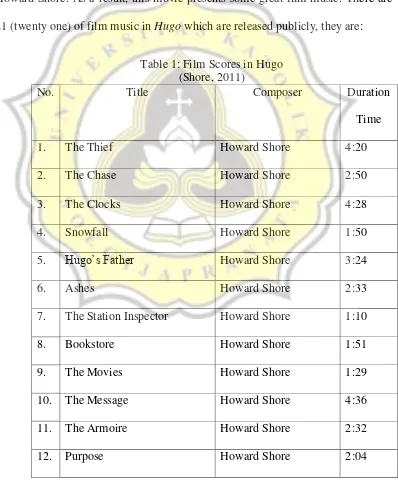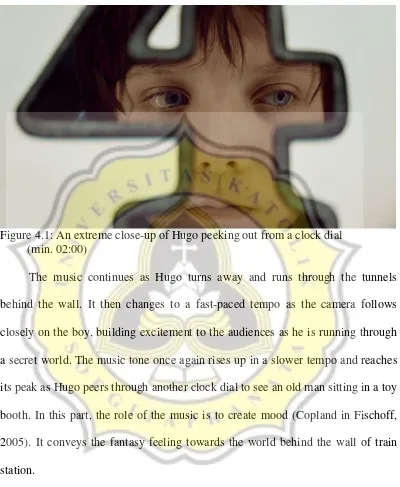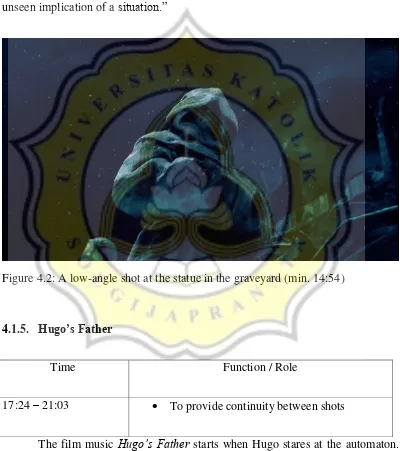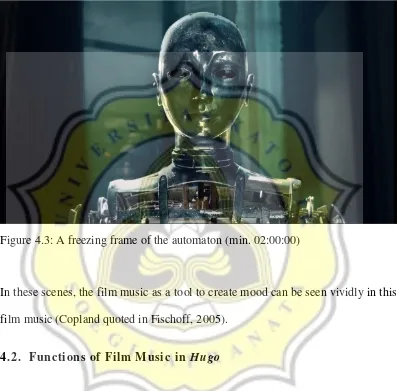CHAPTER IV
DATA ANALYSIS AND INTERPRETATION
4.1. Film Music in Hugo
In producing Hugo, Martin Scorsese collaborated with the composer
Howard Shore. As a result, this movie presents some great film music. There are
21 (twenty one) of film music in Hugo which are released publicly, they are:
Table 1: Film Scores in Hugo
7. The Station Inspector Howard Shore 1:10
8. Bookstore Howard Shore 1:51
9. The Movies Howard Shore 1:29
10. The Message Howard Shore 4:36
11. The Armoire Howard Shore 2:32
13. The Plan Howard Shore 2:48
14. Trains Howard Shore 2:50
15. Papa Georges Made Movies Howard Shore 1:52
16. The Invention of Dreams Howard Shore 6:28
17. A Ghost in the Station Howard Shore 6:00
screen in the movie. Film scores usually do not have lyrics so as not to compete
with dialogue.
Film music used in Hugo are in overall featuring period instruments typical
of a 1930s Paris cafe band, such as accordion, gypsy guitar, double bass, alto sax,
trap drum-kit, tack piano and ondes Martenot. These music instruments provide a
strong background setting of time and place of the film from the beginning to the
end. The music instruments also define the genre of the film, which is children’s
fantasy adventure and establish the geographical and temporal setting of the film,
In order to better analyze and understand the film music used in Hugo, the
writer will provide the following discussions about the film music in the movie.
4.1.1. The Thief
The Thief is used on the opening scene where a clockwork fading into an
image of Paris until the time Hugo sneaks out to steal from a toy booth (min.
00:47 – 05:03). The use of bird’s eye view together with the music creates a
convincing atmosphere of time and place. The dissonant chord at the beginning
gives a feeling of mystery as the camera moves to show a Paris train station from
above, the venue where the story takes place. The harmony then builds up as the
camera moves through the station and through the white smoke. The tone starts
brought back through time to Paris in 1931.
In line with Cohen (2001), the music used in the film, up to the point when
and where the time and place are set in the opening credits of a film, serves the
puts this kind of music as a mean to establish a “more convincing atmosphere of
time and place”.
Figure 4.1: An extreme close-up of Hugo peeking out from a clock dial (min. 02:00)
The music continues as Hugo turns away and runs through the tunnels
behind the wall. It then changes to a fast-paced tempo as the camera follows
closely on the boy, building excitement to the audiences as he is running through
a secret world. The music tone once again rises up in a slower tempo and reaches
its peak as Hugo peers through another clock dial to see an old man sitting in a toy
booth. In this part, the role of the music is to create mood (Copland in Fischoff,
2005). It conveys the fantasy feeling towards the world behind the wall of train
station.
As Hugo crawls out from behind the wall to sneak into the toy booth, the
violin plays in dissonant chords to elicit a feeling of tension. The music also gets
louder to support the dramatic feeling. Here, according to Copland’s theory
(Fischoff, 2005), music is used to underline a psychological refinement to
4.1.2. The Chase
Time Function / Role
07:02 – 09:34 To create mood
The Chase is used during the scene where the station inspector runs after
Hugo after he is caught stealing from Melies’ toy booth (min. 07:02 until 09:34).
The loud and fast-paced tempo and the uplifting orchestra induce a running
sensation. The fast tempo also pushes the scene to appear faster than its actual
pace. In Copland’s opinion (quoted in Fischoff, 2005), this music is used to
highlight the atmosphere of time and place. Moreover, Shore (2011) uses minor
keys in The Chase to create intriguing and disturbing effects.
4.1.3. The Clocks
Time Function / Role
09:36 – 12:58 To create a more convincing atmosphere,
To express the inner feeling of characters.
To induce mood.
30:12 – 30:33 To be a neutral background filler
In general, The Clocks serves the functions of creating a more convincing
atmosphere (Copland in Fischoff, 2005) and inducing mood (Cohen, 2001). On
the scene when Hugo runs back to his house beyond the wall to wind up the clock.
(minutes 09:36 – 12:58), the music slowly changes from The Chase into The
atmosphere of place (Copland quoted in Fischoff, 2005) that is inside a big clock
on the station.
On minute 11:05 when Hugo winds the clockwork, he looks out to see
Monsieur Frick trying to approach Madame Emilie. The waltz music conveys the
fantasy of romance between Madame Emilie and Monsieur Frick. According to
Copland (quoted in Fischoff, 2005), the music can be used to express the inner
feelings of the characters on screen. The music once again turns into a slower
calm melody as Hugo finishes winding the clocks and takes a moment to look
over the city of Paris from the very top of the station. The slow tempo alternates
the perception of time by dragging the scene. The tone then rises up as the camera
floats away, showing Paris city from above using bird’s eye view, and reaching its
highest tone as the title of the film shows up on screen. Here the music is used to
induce mood at the beginning of the film (Cohen, 2001).
When Hugo and Isabelle part away in front of the library (min. 30:12 –
30:33), the music is subtle as not to interfere the dialogues. The film music is
used, in Copland’s term (quoted in Fischoff, 2005), as a neutral background filler
to fill the pause between the conversation of Hugo and Isabelle.
4.1.4. Snowfall
Time Function / Role
14:19 – 15:13 To underline psychological refinements
The film music of Snowfall is used when Hugo decides to get out of the
train station to follow Melies. The music invokes a feeling of terror through the
to express Hugo’s fear towards the world outside the train station. When Hugo
and Melies walk through a graveyard, a melody from bass playing at its lowest
range is heard as the camera takes a low-angle shot of the stone statue to
exaggerate its size (Figure 4.2), thus enhancing the emotional experience.
Snowfall is used, borrowing Copland’s words (quoted in Fischoff, 2005), to
emphasize psychological refinement, “the unspoken thoughts of a character or the
unseen implication of a situation.”
Figure 4.2: A low-angle shot at the statue in the graveyard (min. 14:54)
4.1.5. Hugo’s Father
Time Function / Role
17:24 – 21:03 To provide continuity between shots
The film music Hugo’s Father starts when Hugo stares at the automaton.
This film music provides a continuity between shots (Cohen, 2001). As the
automaton. The automaton then changes back to the past, and the music turns to a
slow subtle melody as voices of Hugo talking to his father takes over. The
shrieking violin is a cue to a flashback (Cohen, 2001).
4.1.6. Ashes
Time Function / Role
21:30 - 23:33 To create mood
To build a sense of continuity between shots
26:36 - 27:24 To create mood
On the scene where Hugo has a flashback to the time Uncle Claude comes
after his father dies and takes him away to the train station (min. 21:30 – 23:33),
the music helps to create a sad mood. Moreover, the music also helps to connect
the shots together as the shots jump in time and places.
The music recurs at the scene where Melies gives Hugo ashes in a
handkerchief to pretend that he has burned the notebook (min. 26:36 – 27-24).
The slow sad music accompanies Hugo as he slowly opens the handkerchief, and
heightens up as the ashes get fully revealed and flown away in a slow motion. In
general, the function of the film music, Ashes, in the scenes mentioned above is to
enhance atmosphere and to build a sense of continuity as proposed by Copland
4.1.7. The Station Inspector
Time Function / Role
24:35 - 26:01 To express the inner feeling of the character
36:00 - 38:10 To express the inner feeling of the character
43:02 - 44:42 To express the inner feeling of the character
01:08:20 - 01:08:27 To express the inner feeling of the character
01:26:10 - 01:27:00 To express the inner feeling of the character
The Station Inspector film music expresses the inner feeling of the station
inspector by focusing on his character and personality (Copland quoted in
Fischoff, 2005). The music occurs almost each time the station inspector shows
upon the screen. The proud marching music signifies the character as a brave
soldier. The minor keys create a dark feeling, introducing the character as the
villain of the story. The music helps in telling the audiences the character of the
station inspector.
4.1.8. Bookstore
Time Function / Role
28:00 - 28:52 To express the inner feeling of the character
Bookstore starts as Isabelle and Hugo walk to the bookstore after he runs
into her (min. 28:00 – 28:52). As Isabelle mentions the bookstore as “the most
adventure in books. The music changes into a minor melody as Monsieur Labisse
39:22 - 40:11 To enable a symbolization of past and future
events through the use of leitmotif
To create mood
The Movies plays in the background from the moment Isabelle holds
Hugo’s hand at the library to the time when they sneak in to a movie theater (min.
39:22 – 40:11). The music starts with a very soft melody which is barely audible.
As the screen changes to show a movie theater, a leitmotif musical phrase that is
associated with Georges Melies occurs to symbolize the events of the filmmaker.
Moreover, the magical melody of the leitmotif enhances the audiences’ feeling of
magic and wonder (Copland quoted in Fischoff, 2005).
4.1.10. The Message
Time Function / Role
53:09 - 54:50 To enable a symbolization of past and future
To create mood
Similar to the film music The Movie, film music The Message serves as a
means to enable “a symbolization of past and future events through the use of
leitmotif” (Cohen, 2001) and to create mood (Copland quoted in Fischoff, 2005).
The film music occurs when the automaton finally works after Isabelle lends
Hugo the heart-shaped key (min. 34:35 – 35:41). The fast rhythm and the uplifting
melody of the music invoke an exciting mood. The occurrence of the leitmotif 2001) and to create mood (Copland quoted in Fischoff, 2005) is The Armoire. The music occurs when Hugo and Isabella search for the notebook in the armoire
while hiding from Papa Georges in the bedroom. The pitch of the string
instrument alters the scene into an exciting suspense feeling. As Isabelle tries to
pull out the heavy wooden box carefully, the pitch reaches into higher octaves to
invoke a tense mood. The music then stops as the box lands safely in Isabelle’s
feeling of relief to the audiences before the chair completely brakes and both
Isabelle and the box fall. As hundreds of papers scatter through the air out of the
box, the loud music helps in creating a fantasy feeling. The leitmotif melody also
occurs to enable a symbolization of the events of Georges Melies.
4.1.12. Purpose
Time Function / Role
01:18:47 - 01:19:54 To create mood
Purpose is used to create mood (Copland quoted in Fischoff, 2005). It
appears on the scene where Hugo talks about how he likes to fix things to Isabelle
while he is winding the clock. The use of violin in the music expresses the passion
of Hugo. Violin is commonly thought of as the most expressive instrument in the
orchestra and thus linked to passion (Kalinak, 2010, p. 14).
4.1.13. Trains
Time Function / Role
01:51:07 - 01:51:40 To create a more convincing atmosphere of
place
To create mood
Trains is the background music on the scene where Hugo is chased by the
station inspector after Uncle Claude has been found died. The automaton
accidentally falls on the train rail and Hugo jumps down after it even though there
more a more convincing atmosphere of the place on the scene (Copland quoted in
Thomas, 1991). The very fast-paced tempo and rhythm of music unconsciously
alter the audiences’ heartbeat to induce sensations of dread and suspense, to create
mood (Copland quoted in Fischoff, 2005).
4.1.14. Papa Georges Made Movie
Time Function / Role
01:28:50 - 01:30:28 To create mood
01:31:23 - 01:32:52 To create mood
The film music accompanies the scene where Rene Tabard comes over and
meets Mama Jeanne (min. 01:28:50 - 01:30:28). The lovely melody of the piano
signifies that Mama Jeanne finally opens up about the past, releasing the tense
situation. When they watch the film together on min 01:31:23, the melody turns
into a harmony. The choice of music, which is in line with Copland (quoted in
Fischoff, 2005), creates a beautiful loving feeling to the audiences.
4.1.15. The Invention of Dreams
Time Function / Role
01:34:30 - 01:35:33 To create mood
The Invention of Dreams is used on the flashback scenes of Melies’ past as
a magician. The music starts with the leitmotif melody. A younger Melies is on
helps to create a lively mood. The Invention of Dreams is used as a medium to
create mood (Copland quoted in Fischoff, 2005).
4.1.16. The Magician
Coeur Volant is used as the closing music of the film. The music starts on
the last scene where Isabelle sits down to start writing the story about Hugo in the
middle of the party. The camera floats around the room as Isabelle’s voice over is
narrating the story. The music starts in a very soft and subtle melody as to not
interfere with the narrating. The camera then moves to the next room to take a
close-up shot at the automaton. The tone starts to rise and then stops as the screen
the music as the screen changes to show the end credit, and a female singer sings
along in French. The music is soothing, giving a gently calming effect to the
audience by using major key. Moreover, the use of freezing frame on the last
scene is to convey the powerful ending of the whole film.
Figure 4.3: A freezing frame of the automaton (min. 02:00:00)
In these scenes, the film music as a tool to create mood can be seen vividly in this
film music (Copland quoted in Fischoff, 2005).
4.2. Functions of Film Music in Hugo
To make a clearer interpretation on what functions the film music has
toward the scenes in Hugo, the table below summarizes the functions of film
music in Hugo.
Table 2: The Functions of Film Music in Hugo
No. Film Music Functions
atmosphere of time and place,
To express the inner feeling of
character,
To induce mood,
To be a neutral background filler
4. Snowfall To underline psychological
refinements.
5. Hugo’s Father To provide continuity between
shots
6. Ashes To create mood,
To build a sense of continuity
between shots
7. The Station Inspector To express the inner feeling of
character
8. Bookstore To express the inner feeling of
character
and future events through the use
of leitmotif,
To create mood.
10. The Message To enable symbolization of past
and future events through the use
From the table above, it is clear that the film music in Hugo serves various
the film, from creating moods, atmosphere of time and place, and also to express
the inner feeling of the characters. The use of leitmotif melody which represents
Georges Melies also helps in relating the events in the story easily through



